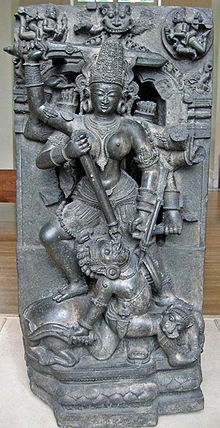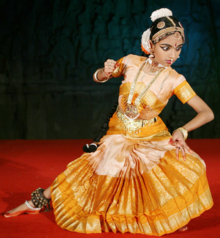Durga: Difference between revisions
m →Further reading: ISBN format |
→External links: Weblink to the 108 names of Durga from Durgāsaptaśatī |
||
| Line 114: | Line 114: | ||
*[http://www.calcuttaweb.com/puja/ Durga Puja (calcuttaweb.com)] |
*[http://www.calcuttaweb.com/puja/ Durga Puja (calcuttaweb.com)] |
||
*{{dmoz|Society/Religion_and_Spirituality/Hinduism/Gods_and_Goddesses/Durga/|Durga}} |
*{{dmoz|Society/Religion_and_Spirituality/Hinduism/Gods_and_Goddesses/Durga/|Durga}} |
||
*[http://www.stutimandal.com/gif_devi/durga_shatnaam.htm 108 names of Durga] Quelle Source: [[Durgāsaptaśatī]] |
|||
{{HinduMythology}} |
{{HinduMythology}} |
||
Revision as of 09:02, 9 June 2009
| Durga | |
|---|---|
| Devanagari | दुर्गा |
In Hinduism, the goddess Durga (दुर्गा, "the inaccessible"[1] or "the invincible"[2]) or Maa Durga (Mother Durga) "one who can redeem in situations of utmost distress".[citation needed] Durga is a form of Devi, the supremely radiant goddess, depicted as having ten arms, riding a lion or a tiger, carrying weapons (including a Lotus flower), maintaining a meditative smile, and practicing mudras, or symbolic hand gestures.
An embodiment of creative feminine force (Shakti), Durga exists in a state of svātantrya (dependence on the universe and nothing/nobody else, i.e., self-sufficiency) and fierce compassion. Durga is considered by Hindus to be an aspect of Kali, and the mother of Ganesha, and Kartikeya.[3] She is thus considered the fiercer, demon-fighting form of Shiva's wife, goddess Parvati. Durga manifests fearlessness and patience, and never loses her sense of humor, even during spiritual battles of epic proportion.
The Divine belief
The word Shakti, means divine feminine force, and Durga is the warrior aspect of the Divine Mother. Other incarnations include Annapurna and Karunamayi (karuna = kindness). Durga's darker aspect Kali is represented as the consort of god Shiva, on whose body she is often seen standing.
Durga's form is blindingly bright, as a radiant goddess (devi), with three lotus-like eyes, ten powerful hands, lush hair with beautiful curls, a red-golden glow from her skin and a quarter moon on her forehead. She wears a shiny attire emitting fierce rays. Her ornaments were carved beautifully of gold, with ocean pearls and precious stones embedded in it.

As a Goddess, Durga's feminine power contains the energies of the gods. Each of her weapons was gifted to her by various gods: Rudra's trident, Vishnu's discus, Indra's thunderbolt, Brahma's kamandalu, Kuber's Ratnahar, etc.
According to the narrative from the Devi Mahatmya story of the Markandeya Purana text, Durga was created as a warrior goddess to fight an asura, (an inhumane force/demon) named Mahishasur. He had unleashed a reign of terror on earth, heaven and the nether worlds, and he could not be defeated by any man or god, anywhere. So the gods went to Brahma who had given Mahishasur the boon to be the invincible conqueror of the universe. Brahma could not do anything. So they made Brahma their leader and went to Baikuntha-the place where Vishnu lay on Anantya Naag. They found both Vishnu and Shiva there and Brahma eloquently reported the reign of terror Mahishasur had unleashed on the three worlds. Hearing this both Vishnu, Shiva and all the gods got very angry and beams of fierce light emerged from each of their body. This blinding sea of light met at the Ashram of the priest Katyan. Thus the goddess Durga took the name Katyani from the priest and emerged from the sea of light. She gave her own introduction in the language of Rig-Veda saying that she was the form of the supreme Brahman and had created all the gods. Now she had come to fight the demon to save the gods. The gods did not create her, it was her leela that she emerged from their combined energy. The gods were blessed with her compassion.
It is said that upon initially encountering Durga, Mahishasura underestimated her thinking "How can a woman kill me-Mahishasur the one who has defeated the god trinity". However, Durga gave a roar of laughter which caused earthquake on the earth and this woke Mahishasur up to her powers.
And the terrible Mahishasur rampaged against her, changing forms many times. First he was a buffalo demon, and she defeated him with her sword. The he changed forms and became an elephant that tied up the goddesses' tiger and began to pull it towards him. The goddess cut off his trunk with her Khorgo. The demon Mahishasur continued his terrorizing, taking the form of a lion, and then the form of a man, but both of them were gracefully slain by the goddess Durga.
Then Mahishasur began attacking once more, starting to take the form of a buffalo again. The patient goddess became very angry, and as she sipped divine wine from a cup she smiled and proclaimed to Mahishasur in a colorful tone - "Roar with delight while you still can O illiterate demon, because when I will kill you after drinking this, the gods themselves will roar with delight". When Mahashaur had half emerged into his buffalo form, he got paralyzed by the extreme light emitting from the goddess's body. The goddess then resounded with laughter before cutting Mahishasur's head down with her Khorgo.
And thus Durga slayed Mahishasur, thus is the power of the fierce compassion of Durga. Hence Mata Durga is also known as Mahishasurmardhini – the slayer of Mahishasur.
Worship

The four day long Durga Puja is the biggest annual festival in Bengal, Orissa and Bihar. It is celebrated likewise with much fervour in other parts of India, especially the Himalayan region, but is celebrated in various forms throughout the Hindu universe.
The day of Durga's victory is celebrated as Vijaya Dashmi, Dashain or Dussehra - these words literally mean "the Victorious Tenth" (day).
In Kashmir she is worshipped as shaarika (the main temple is in Hari Parbat in Srinagar).
The actual period of the worship however may be on the preceding nine days (Navaratri) followed by the last day called Vijayadashami in North India or five days in Bengal (from the sixth to tenth day of the waxing-moon fortnight). Nine aspects of Durga known as Navadurga are meditated upon, one by one during the nine-day festival by devout Shakti worshippers.
In North India, the tenth day, signifying Rama's victory in his battle against the demon Ravana, is celebrated as Dussehra - gigantic straw effigies of Ravana are burnt in designated open spaces (e.g. Delhi's Ram Lila grounds), watched by thousands of families and little children.
In Mysore Karnataka, she is worshipped as Chamundeshwari, the patron goddess of the city during Dussehra
In Gujarat it is celebrated as the last day of Navaratri, during which the Garba dance is performed to celebrate the vigorous victory of Mahishasura-mardini Durga.
The Goddess Durga is worshiped in her peaceful form as Maha Gauri, The Fair Lady, Shree Shantadurga also known as santeri, is the patron Goddess of Goa. She is worshiped by all Goan Hindus irrespective of caste.
Notable temples in India

- Matrimandir in the city of Auroville near Pondicherry in Tamil Nadu.
- Ambika Mata Temple in the village of Jagat near Mount Abu in Rajasthan, India.
- Bhairabi Devalaya, in Tezpur, Assam
- Kalighat Temple, Kolkata.
- Kamakhya Temple, Guwahati, Assam
- Kanaka Durga Temple, Vijayawada, Andhra Pradesh
- Shanta Durga temple in Goa
- Shila Devi temple at Amber Jaipur Rajasthan
- Shitla Mata temple at Patna Bihar
- Amaramkavu temple at Kolani Thodupuzha Kerala
- Chintpurni Temple at una Himachal Pradesh
- Jwalamukhi Temple - Kangra, Himachal Pradesh
- Chamunda Devi - Kangra, Himachal Pradesh
- Chamundeshwari Temple, Mysore Karnataka
- Jhakhu Temple - Shimla, Himachal Pradesh
- Naina Devi Temple - Bilaspur Himachal Pradesh
- Bhimakali Temple - Sarhan Himachal Pradesh
- Hadimba Devi Temple - Manali Himachal Pradesh
- Balasundari Temple - Nahan Himachal Pradesh
See also

- Kali
- Durga Puja
- Shantadurga
- Hindu Goddess
- Kala, husband of Durga in Javanese mythology.
- List of women warriors in folklore, literature, and popular culture
References
- ^ Encyclopædia Britannica. 2007. Encyclopædia Britannica Online. 25 Feb. 2007 < http://www.britannica.com/ebc/article-9363243/Durga">.
- ^ "Duods_and_goddesses/durga.htm>.
- ^ Offering Flowers, Feeding Skulls: Popular Goddess Worship in West Bengal By June McDaniel p.225
Further reading
- Durga Puja: Yesterday, Today and Tomorrow, Sudeshna Banerjee, Rupa and Co, Calcutta, 2004. (ISBN 81-291-0547-0)
- Hindu Goddesses: Vision of the Divine Feminine in the Hindu Religious Traditions, David Kinsley. (ISBN 81-208-0379-5)
- Grace and Mercy in Her Wild Hair : Selected Poems to the Mother Goddess, Ramprasad Sen (1720-1781). (ISBN 0-934252-94-7)
- Durga Puja Beginner, Swami Satyananda Saraswati, Devi Mandir, 2001. (ISBN 1-887472-89-4)
- "Chandi Path", Swami Satyananda Saraswati, Devi Mandir (ISBN 1-877795-52-6)
- "Chandi Path: Study of Chapter One", Swami Satyananda Saraswati, Devi Mandir (ISBN 1-877795-58-5)
- "Chandi Path: Study of Chapter Two", Swami Satyananda Saraswati, Devi Mandir (ISBN 1-877795-60-7)
- Offering Flowers, Feeding Skulls: Popular Goddess Worship in West Bengal, June McDaniel, Oxford University Press, 2004. (ISBN 0195167910)
- "Pronunciation and the Chandi Samputs", Swami Satyananda Saraswati, Devi Mandir (ISBN 1-877795-61-5)
- "Devi Gita", Swami Satyananda Saraswati, Devi Mandir (ISBN 1-877795-56-9)
- The Bond Between Women: A Journey to Fierce Compassion, China Galland, Riverhead Trade Publishing, U.S., 1999.
- Mahishasura Mardini Stotram (Prayer to the Goddess who killed Mahishasura), Sri Sri Sri Shankara Bhagavatpadacharya

